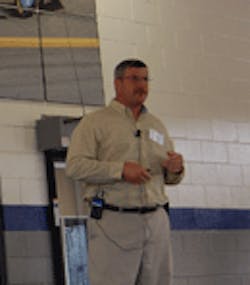Chester, VA. As the full implementation of the Federal Motor Carrier Safety Administration’s (FMCSA) new Comprehensive Safety Analysis 2010 (CSA 2010) regulatory package approaches, carriers are being encouraged to completely rethink their safety management practices. That way, fleets will be more in line with the overall goal of FMCSA’s overhaul of trucking safety rules: reducing the risk of crashes and thus lowering the number of highway fatalities.
“It’s important to remember here that the feds are not re-writing the whole rule book here; they are actually reinterpreting it, along with the safety data they receive, in order to get a better handle on what can be done to reduce vehicle crashes,” explained Gil Trevino, a safety specialist with Penske Truck Leasing.
Trevino provided an overview of how CSA 2010 is going to change trucking safety regulation as part of Penske’s Discovery Forum 2010 – a series of meetings being held at select sites within its network of nearly 1,000 facilities across the U.S. for Penske customers and prospects. (See video from the Discovery Forum 2010)
A former South Carolina state transportation police officer, Trevino explained during a presentation this week at Penske’s Chester, VA, location that one of the main goals of CSA 2010 is to more closely link the safety performance of drivers and carriers through continually updated metrics in order to gain a more accurate and timely trucking safety picture.
“The prism FMCSA is viewing all of this through is reducing crash risk,” he told Fleet Owner. “That’s why they want to reaffirm the connections between the driver, vehicle, and carrier. Ultimately, what happens through this is that you, the carrier, become ultimately responsible for all the components of safety. It’s your vehicle; it’s your driver.”
Trevino pointed to highway fatality statistics to illustrate the agency’s mindset. “In 2008, one out of every nine highway fatalities involved what’s called a ‘large vehicle,’ ones weighing over 10,000 lbs.,” he said. “That’s why FMCSA is so focused on using CSA 2010 to reduce the crash risk of commercial trucks.”
Trevino also stressed that safety ratings under CSA 2010 could fluctuate on a month-to-month basis – varying between unfit, marginal, and operational – depending on the results of ongoing roadside inspection reports, among other metrics.
He added that how FMCSA enforces safety is also going to change, with the agency expecting 25% of its enforcement time will be spent on comprehensive onsite carrier inspections, another 45% on investigations with a single specific focus, and the remaining 30% on “offsite” investigations.
“This is a better use of manpower for them, especially as they have more limited resources,” Trevino said. “But the bottom line is, you will see an increase in roadside inspections. Everything [in CSA 2010] is geared to more inspections in more detail, for that is what’ll largely generate the safety ratings for carriers.”
About the Author
Sean Kilcarr
Editor in Chief
Sean Kilcarr is a former longtime FleetOwner senior editor who wrote for the publication from 2000 to 2018. He served as editor-in-chief from 2017 to 2018.
